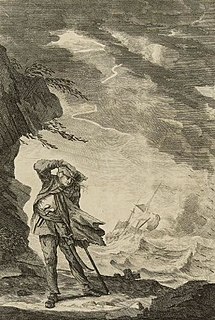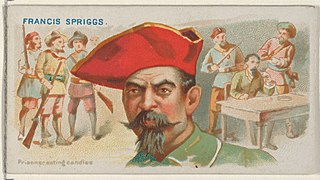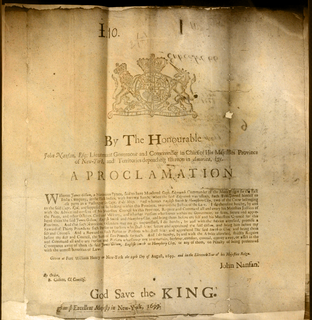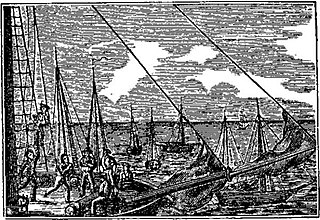
Daniel Defoe was an English writer, trader, journalist, pamphleteer and spy. He is most famous for his novel Robinson Crusoe, published in 1719, which is claimed to be second only to the Bible in its number of translations. He has been seen as one of the earliest proponents of the English novel, and helped to popularise the form in Britain with others such as Aphra Behn and Samuel Richardson. Defoe wrote many political tracts, was often in trouble with the authorities, and spent a period in prison. Intellectuals and political leaders paid attention to his fresh ideas and sometimes consulted him.

Bartholomew Roberts, born John Roberts, was a Welsh pirate and the most successful pirate of the Golden Age of Piracy, taking over 400 prizes in his career. Roberts raided ships off the Americas and the West African coast between 1719 and 1722; he is also noted for creating his own Pirate Code, and adopting an early variant of the Skull and Crossbones flag.
Philip Ashton (1702—1746) was a castaway on then-uninhabited Roatán island in the Gulf of Honduras for 16 months in 1723/1724. His memoirs about his solitary stay were published in book form in Boston in 1725. While some people believed it was a novel in the style of Robinson Crusoe (1719), Ashton's book was the account of a genuine experience. He was born in Marblehead, Massachusetts in 1702 and married twice.

Edward "Ned" Low was a notorious pirate of English origin during the latter days of the Golden Age of Piracy, in the early 18th century. Low was born into poverty in Westminster, London and was a thief from an early age. He moved to Boston, Massachusetts as a young man. His wife died in childbirth in late 1719. Two years later, he became a pirate, operating off the coasts of New England and the Azores, and in the Caribbean.

George Lowther was an English pirate who, although little is known of his life, was reportedly active in the Caribbean and Atlantic during the early 18th century. His First Mate was Edward Low.

Thomas Anstis was an early 18th-century pirate, who served under Captain Howell Davis and Captain Bartholomew Roberts, before setting up on his own account, raiding shipping on the eastern coast of the American colonies and in the Caribbean during what is often referred to as the "Golden Age of Piracy".
Jeremiah Cocklyn, better known by the name Thomas Cocklyn, was an English pirate known primarily for his association with Howell Davis, Olivier Levasseur, Richard Taylor, and William Moody.

A General History of the Robberies and Murders of the most notorious Pyrates is a 1724 book published in Britain containing biographies of contemporary pirates, which was influential in shaping popular conceptions of pirates. Its author uses the name Captain Charles Johnson, generally considered a pen name for one of London's writer-publishers. The prime source for the biographies of many well-known pirates, the book gives an almost mythical status to the more colourful characters, and it is likely that the author used considerable licence in his accounts of pirate conversations. The book also contains the name of the pirate flag the Jolly Roger and shows the skull and bones design.
John Fenn was an early 18th-century English pirate who sailed with Captain Bartholomew Roberts and later had a brief partnership with Thomas Anstis.

Francis Spriggs was a British pirate who, associated with George Lowther and Edward Low, was active in the Caribbean and the Bay of Honduras during the early 1720s.

James Gilliam, or James Kelly was an English pirate and buccaneer active off the coasts of Spanish South and Central America and later in the Indian Ocean. He sailed under several different pirate captains but is best remembered for his brief association with William Kidd.
Charles Harris (1698-1723) was an English pirate active in the 1720s. He is best known for his association with George Lowther and Edward Low.

John Phillips was an English pirate captain. He started his piratical career in 1721 under Thomas Anstis, and stole his own pirate vessel in 1723. He died in a surprise attack by his own prisoners. He is noted for the articles of his ship, the Revenge, one of only a few complete sets of pirate articles to survive from the so-called Golden Age of Piracy.
Richard Shipton was a pirate active in the Caribbean, best known for sailing alongside Edward Low and Francis Spriggs. In 1723 Shipton was elected captain of Merry Christmas, and he subsequently captained ships such as Royal Fortune, York, and John and Mary. Forced to beach his vessel on western Cuba by pirate hunters, in early 1726, he was found ashore in his bed and presumed to have died shortly afterwards.

Philip Lyne was a pirate known for his cruelty and his association with Francis Spriggs.
Thomas White was an English pirate active in the Caribbean and the Indian Ocean. He was only briefly a captain on his own but served under several more prominent captains such as George Booth, John Bowen, Thomas Howard, John Halsey, and Nathaniel North.
Richard Noland was an Irish pirate active in the Caribbean. He was best known for sailing with Samuel Bellamy before working for the Spanish.

William Lewis was a pirate supposedly active in the Caribbean, off the American east coast, and off the west coast of Africa in the 18th century. He was known for sparing his victims and for being killed after announcing he had made a pact with the Devil. He is likely the fictional creation of "Captain Charles Johnson" who presented his story among those of real historical pirates.
David Williams was a Welsh sailor who turned pirate after being abandoned on Madagascar. He was only briefly a Captain, and is best known for sailing under a number of more prominent pirate captains.
George Spurre was an English pirate and buccaneer. He is best known for sacking Campeche and for joining a large buccaneer force which captured Veracruz.












